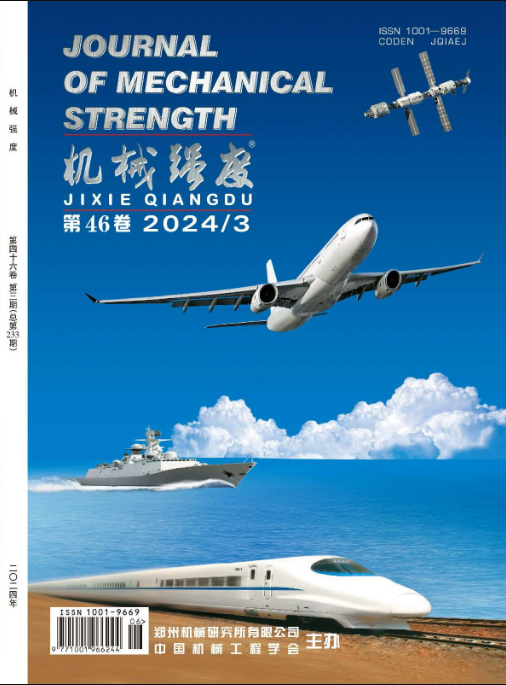STRENGTH PREDICATION FOR LOAD-BEARING JOINTS OF THREE-DIMENSIONAL BRAIDED COMPOSITES
Q4 Engineering
引用次数: 2
Abstract
Load response and failure modes of three-dimensional four-directional braided composite lugs were studied analytically and experimentally. The objective of the study was to get information on the stiffness, strength and failure mode of the lug, as well as on the applicability of the analysis method used to predict lug load response and failure. The analyses were performed using finite element method. Parabolic solid brick elements were used. A steel pin was modeled to apply the loading. The loading was applied with a constant force distribution through the center of the pin. A contact was defined between the pin and the surrounding lug surface. The test lugs were manufactured with the resin transfer molding (RTM) technique. The test specimens were loaded parallel to the lug centerline. Two types of specimens were tested. There are three basic failure modes in braided composite joints: net-tension, shear-out, and bearing. Net-tension failure is associated with matrix and fiber tension failure due to stress concentrations. Shear-out and bearing failures result primarily from the shear and compression failures of fiber and matrix. The measured strains showed fairly good correlation with the analysis results. The strain response was almost linear. It can be concluded that with correct material properties the FE(finite element) approach used in the analyses can provide a reasonable estimate for the load response and failure of 3-d braided composite lugs.三维编织复合材料承载节点强度预测
对三维四向编织复合材料凸耳的载荷响应和破坏模式进行了分析和实验研究。该研究的目的是获得有关耳片的刚度,强度和破坏模式的信息,以及用于预测耳片载荷响应和破坏的分析方法的适用性。采用有限元法进行了分析。采用抛物面实心砖构件。模拟了一个钢销来施加载荷。载荷以恒定的力分布通过销的中心施加。定义了销与周围凸耳表面之间的接触。测试耳片采用树脂传递模塑(RTM)技术制造。试件平行于凸耳中心线加载。试验了两种类型的标本。编织复合材料节点存在三种基本破坏模式:净张拉破坏、剪切破坏和承载破坏。净张力破坏与应力集中引起的基体和纤维张力破坏有关。剪切破坏和承载破坏主要是由纤维和基体的剪切和压缩破坏引起的。实测应变与分析结果具有较好的相关性。应变响应几乎是线性的。结果表明,在材料性能正确的情况下,采用有限元分析方法可以对三维编织复合材料凸片的载荷响应和破坏进行合理的估计。
本文章由计算机程序翻译,如有差异,请以英文原文为准。
求助全文
约1分钟内获得全文
求助全文
来源期刊

Journal of Mechanical Strength
Engineering-Mechanical Engineering
CiteScore
0.70
自引率
0.00%
发文量
5969
期刊介绍:
Journal of Mechanical Strength is an academic and technical journal governed by China Machinery Industry Federation,sponsored by Zhengzhou Research Institute of Mechanical Engineering Co., Ltd. and Chinese Mechanical Engineering Society. It mainly publishes research articles, reviews and newsletters with innovative, economic and practical application in the fields of machinery, strength, vibration and material strength.
Journal of Mechanical Strength was founded in May 1975, bi-monthly issued. The publishing scope covers mechanical structure strength, micro electro mechanical systems (MEMS), reliability, optimization design, mechanical design, calculation methods, fatigue, damage, fracture, vibration, noise, fault diagnosis and monitoring, testing technology, detection and evaluation, testing instruments, experimental stress analysis, residual stress, failure analysis and related interdisciplinary subjects. The aimed readers of the journal are researchers, designers and developers in machinery industry, as well as teachers and students in universities.
The journal is included by the Statistical Source Journal of Chinese Scientific and Technological Papers (Key Magazine of China Technology) (since 1989), Chinese Core Journal (since 1992), Important Chinese Journal of Academic Degrees and Postgraduate Education (since 1995), source journal of the Chinese Science Citation Database (since 1996), Science Abstract (UK) (since 1995), China Quality Scientific and Technological Journals (300 journals) (2008), Top 20 Journals of Natural Science of Henan Province (2008), RCCSE China Authoritative Academic Journal (A+) (2012), and Top 20 Journals of Natural Science of Henan Province (2013). The Journal is also indexed by Scopus Database,Chemical Abstract (CA), Japan Science and Technology Agency (JST), and Report of World Journals Clout Index (WJCI) (2021).
 求助内容:
求助内容: 应助结果提醒方式:
应助结果提醒方式:


